
Cisticola juncidis
SUBFAMILY
Sylviinae
TAXONOMY
Sylvia juncidis Rafinesque, 1810.
OTHER COMMON NAMES
English: Fantailed warbler, streaked cisticola; French: Cisticole
des joncs; German: Cistensдnger; Spanish: Buitrуn Comъn.
PHYSICAL CHARACTERISTICS
3.9–4.7 in (10–12 cm); 0.3–0.4 oz (8–12 g). Small warbler with
warm brown upperparts strongly streaked with black, rufous
rump and flanks, short, rounded wings, and short, graduated tail,
spotted black and white underneath. Bill short, thin, and slightly
decurved.
DISTRIBUTION
Widespread. Southern Europe (Iberian Peninsula, Mediterranean
rim), sub-Saharan Africa, Indian subcontinent, Southeast
Asia, Australasia.
HABITAT
Open tall-grass habitat and grassy wetlands, agricultural lands,
primarily in lowlands.
BEHAVIOR
Mostly sedentary, but marked post-breeding dispersal of both
adults and juveniles in many populations. Also migratory in
Western Mediterranean. Male song is a quick, sharp single
note given consistently every 0.5 to 1 seconds. Males are aggressively
territorial, especially in vicinity of nest.
FEEDING ECOLOGY AND DIET
Forages mostly on the ground. Takes insects and insect larvae,
particularly Lepidoptera, grasshoppers, spiders, and beetles.
REPRODUCTIVE BIOLOGY
Serially monogamous with most males mating with 1–11 females
over the course of a season. Occasionally simultaneously
polygynous. Pair bond lasts for a single nesting. During
courtship, male builds several partially complete nests near the
ground, and attracts female with song-flight. Nest is pearshaped
bag made by sewing and weaving grasses together with
spider web. Two to six eggs incubated by female for 13 days;
young leave nest in 11–15 days. Female feeds young 10–20
days after fledging.
CONSERVATION STATUS
Not threatened.
SIGNIFICANCE TO HUMANS
None known.
Other popular Animals
Photo Gallery of - Zitting cisticola




 Animalia Life
Animalia Life